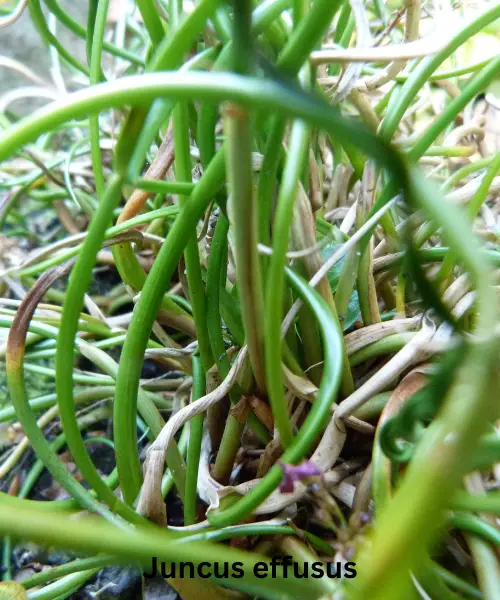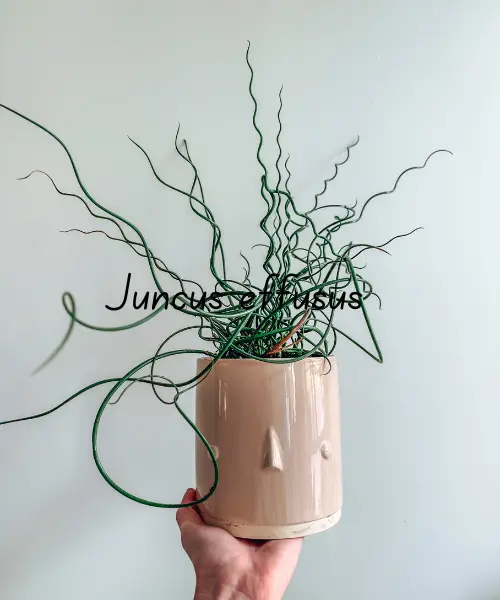If you’re looking to add some truly unique texture and flair to your garden, look no further than corkscrew rush or corkscrew grass (Juncus effusus ‘Spiralis’).
This quirky grass variety gets its name from its tightly spiraled stems that spring outward in an almost sculptural display.
Beloved for its artistic forms and hardy nature, corkscrew grass makes an eye-catching accent plant that brings a sense of movement and life to any landscape.
While it may look delicate and exotic, corkscrew grass is actually fairly easy to grow as long as you meet its basic needs for moist soil and sunlight.
Coming from the rush family rather than being a true grass, this perennial is also surprisingly low-maintenance once established. Read on to learn all about adding corkscrew flair to your own outdoor spaces.
All About Corkscrew Rush
Before we dive into growing tips, let’s explore what makes this plant so special and coveted by gardeners. Corkscrew rush is a cultivar of the common soft rush (Juncus effusus), a grass-like semi-evergreen rushplant native to temperate regions of the Northern Hemisphere.

In the wild type, the round green stems grow straight and upright, forming dense clumps. But in the ‘Spiralis’ variety, the stems follow an entrancing spiral pattern, with the degree of twisting varying from loose cowlicks to super tight corkscrews. The effect is only enhanced as the stems mature, taking on a yellowed, wheat-like tone.
While the hollow spiral stems are the star of the show, the foliage itself is quite attractive too. Soft and slender, the green leaves add gentle texture that contrasts beautifully with the twisted stems.
This unique plant tops out around 2 feet tall and 1-2 feet wide at maturity, with a compact, slowly spreading mound shape. In early summer, small clusters of green rushflowers may appear, followed by small seed capsules, but they are not particularly ornamental.
Corkscrew grass is winter-hardy down to Zone 5, making it a great choice across a wide range of climates. It’s commonly used in water gardens, pond peripheries, rain gardens, or anywhere there is consistently moist soil. However, the plant is remarkably versatile and can also thrive in average garden soil as long as it’s not too dry.
Where to Grow Corkscrew Rush
When choosing a spot to plant corkscrew grass, the main requirements are full to partial sun (at least 6 hours of direct light) and moist soil. Waterlogged areas are ideal, which is why this plant pairs so well with ponds, streams, or low spots that tend to stay wet.
However, you can certainly grow corkscrew rush in an average perennial border or mixed planting too; just be prepared to water it regularly during dry spells. The key is enriching the soil with compost or other organic matter to help it retain moisture.
It’s an excellent choice for difficult, damp areas where few other plants want to grow. At the same time, this low-maintenance perennial can add incredible textural interest to more formal garden designs when used as an accent or repetitive planting.
Corkscrew grass is also well-suited to container gardening, as long as you choose a pot with excellent drainage (more on this below). This allows you to better control the moisture levels surrounding the plant.
How to Plant Corkscrew Rush
Whether starting corkscrew rush from nursery stock, divisions, or seed (be patient as seed is slow to germinate), the planting process is straightforward. Here are the key steps:

How to Grow Corkscrew Grass Plant
1. Prepare the planting area. Clear the site of any debris, weeds, or unwanted vegetation. Amend the soil deeply with compost, peat moss, or other organics to enrich it and help retain moisture. Apply a balanced, slow-release fertilizer at planting time.
2. Dig a hole or trench twice as wide as the rootball or divisions, but no deeper than the height of the rootball. The crown should sit at or slightly above soil level.
3. For potted nursery stock, gently tease apart any tightly wound roots on the outside of the rootball before setting it in the hole. This encourages outward growth.
4. Space divisions or nursery plants around 12–18 inches apart to allow for spreading. Closer spacing is fine if you want a dense planting faster.
5. Fill in around plants with soil, firming it gently to remove air pockets. Leave the crown area exposed.
6. Water deeply right away to help settle the plants in.
Seeds require cold stratification before sowing, so they’re typically started indoors or directly sown outside in fall or winter. Follow the same spacing guidelines as for divisions when sowing.
7. As needed, provide temporary shading or wind protection until new plantings are established.
8. Top off with 2-3 inches of mulch, avoiding the crown area, to retain moisture and minimize weeds.
Corkscrew Rush Care And Maintenance
Once your corkscrew grass planting is established, it’s remarkably resilient and needs very little pampering. In fact, one of the great things about this rush is that it pretty much takes care of itself with proper initial conditions. However, following these simple care tips will help ensure peak growth and keep the corkscrews looking their twistiest:
Watering: Keep soil consistently moist but not waterlogged. A 2-3-inch layer of mulch helps retain moisture. Plants need about 1 inch of water weekly in dry spells.
Fertilizing: Apply a balanced, granular fertilizer in early spring, following product instructions. Mature plants need little supplemental feeding if they are well-mulched.
Pruning: Divide thick, congested clumps every 3–4 years in late winter to rejuvenate and propagate new plants. Remove any dead or damaged stems at this time as well.
Splitting: Every couple of years, you may notice emerging stems trying to spiral one way, while others spiral the opposite direction. Don’t worry; this is normal behavior called “reversible spiraling.” You can leave them be or split the clump into single-direction sections if you prefer.
Winter protection: Evergreen in mild climates, but provide a good 2-4 inch mulch layer in colder areas after the ground freezes.
Disease and pest problems: deer are resistant to and undisturbed by most pests and diseases. Remove any diseased or dead growth promptly. Spiral stems can collect crud, so clean periodically with a stiff brush and water if needed.
Corkscrew grass is considered an invasive species in some regions, spreading via underground rhizomes and self-seeding. Check local listings and aggressively remove any unwanted new growth if listed as noxious where you garden. Most gardeners don’t experience excessive spreading, but stay vigilant.
Design Ideas And Companions
Integrating corkscrew rush into your landscape allows you to get really creative with form, color, and texture. The ethereal spirals bring sculptural flair to borders, beds, and containers while complementing more structural elements like evergreens, boulders, or hardscaping.
Mass plantings of Juncus spiralis are stunning, creating a flowing sea of twisted shapes that catch light and motion. But it also works nicely as a single accent or dramatic focal point in scaled-down settings. Let this vertical plant take center stage in a courtyard, hellstrip, or front entryway.
When grown in damp areas, corkscrew grass blends beautifully with other moisture-loving plants like taro, iris, astilbe, forget-me-nots, and ferns. In standard border plantings, juxtapose the soft grassy texture against spiky perennials like sea holly or globe thistle. The contrasts are visually exciting.
For containers, pair it with trailing plants like sweet potato vine for an eye-catching thriller/spiller combo. Complement the soft textures with smooth decorative stones or glazed ceramics.
Include corkscrew rush in seasonal planters too for unique fall and winter interest. The golden-yellow corkscrews provide color and movement as the weather cools, complementing fall bloomers like chrysanthemums or rich foliage tones. Cut stems also make excellent, long-lasting dried decorations for Thanksgiving and Christmas displays.
No matter how you incorporate this enchanting grass into your landscape design, it’s sure to be a conversation starter! Take advantage of its sculptural qualities by allowing the curling stems to flow unrestrained. Or use sharp pruning techniques to create a more formal, tidy look. With corkscrew rush, you can truly let your artistic side shine through again and again each season.
Where to Buy
Don’t let the unique appearance of corkscrew grass fool you; this plant is increasingly easy to find at garden centers and nurseries across its hardy growing zones. Look for potted nursery stock or divisions in spring and early summer for the best selection and transplant success.
While less common, you can also find seeds available from some specialty catalogs and online retailers. However, germination rates tend to be lower and it can take 1-2 years before spiral stems develop from seed-grown plants.
When shopping for nursery stock, look for plants with healthy, vibrantly colored foliage and tightly spiraled stems. Avoid anything that appears wilted, yellowed, or has pest/disease damage. The twisting pattern is an inherent trait, so there’s no need to hunt for the “perfect” spiral; they’ll all have some variation in form.
If you have trouble locating Juncus ‘Spiralis‘ locally, mail-order is a great option, with many outstanding online nurseries carrying this variety. Inspect any mail-order plants promptly upon arrival and follow the enclosed instructions for proper planting.
You can also propagate new corkscrew rush plants yourself by dividing existing clumps every few years. Follow the steps above for replanting divisions and you’ll have plenty of new curly additions in no time!
Add Corkscrew Sensation to Your Garden
With very few pest or disease issues and minimal maintenance required, Juncus effusus ‘Spiralis’ makes an excellent low-fuss choice for adding year-round texture and whimsy. Whether grown as a single dramatic accent or en masse, these sculptural plants bring such a unique sense of movement and flair to gardens.
Incorporate corkscrew grass into your planting design, and you’re sure to turn heads with its spiraling stems and glowing yellow hues. Mass it at the water’s edges, tuck it into mixed borders, or spotlight it in a classic ceramic container. No matter where you grow this offbeat beauty, it’s guaranteed to be the talk of the neighborhood!
So don’t be afraid to get a little twisted, enjoy the corkscrew sensation, and elevate your garden to new artistic heights. With its mesmerizing forms, this remarkable grass cultivar will make you rethink everything you thought you knew about ornamental grasses. Why grow straight and boring when you could have the ultimate in garden chic with the fabulous Juncus ‘Spiralis’ instead?



